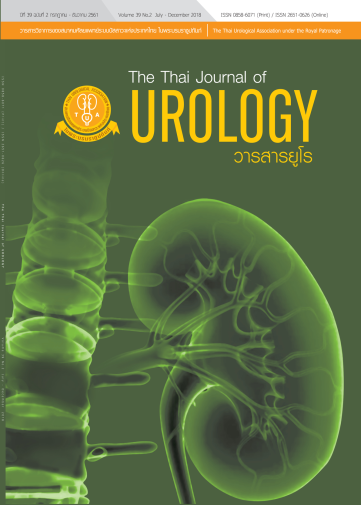Relationship between the spontaneous passage rates of ureteral stones less than 10 mm and serum C-reactive protein levels, white blood cell count and neutrophil percentages
Keywords:
C-Reactive protein, White blood cell count, Neutrophil, medical expulsive therapyAbstract
Background and Objective : A ureteral obstruction that caused by ureteral stone results in inflammatory changes in the inner layer of ureter and prevents the spontaneous passage of the ureteral stone. The objective of this study is to determine the association between spontaneous passage rates of ureteral stones less than 10 mm and serum C-reactive protein levels, white blood cell count and neutrophil percentages.
Materials and Methods : A prospective study was performed in 139 patients who were diagnosed with ureteral stones less than 10 mm in size from March 2016 – January 2017 at Phramongkutklao Hospital. Serum C-reactive protein, white blood cell count and neutrophil percentages were investigated before started medical expulsive therapy. All patients were followed at 4 weeks for spontaneous stone passage. The relationship between these factors and spontaneous stone passage were then examined.
Results : The spontaneous ureteral stone passage rates of the normal serum C-reactive protein level group (0-5 mg/dL) and the high serum c-reactive protein level group were 67% (59/88) and 47.1% (24/51), respectively (p=0.021). The passage rates of ureteral stones in the normal white blood cell count group and the high white blood cell count group were 54.6% (65/109) and 60% (18/30), respectively (p=0.971). The passage rates of ureteral stones in the group with a normal neutrophil percentage and in the group with a higher neutrophil percentage were 58.6% (65/111) and 64.3% (18/28), respectively (p=0.581). On multivariate analysis, normal serum C-reactive protein level (OR=3.27, p=0.008), decreased age (OR=0.97, p=0.019), smaller size of stones (OR=0.61, p<0.001) and distal ureteral stones (OR=2.36, p=0.048) were associated with spontaneous ureteral stone passage.
Conclusion : Serum C-reactive protein level has potential role to predict spontaneous stone passage in patients with ureteral stones less than 10 mm.
References
2. Masarani M, Dinneen M. Ureteric colic: new trends in diagnosis and ttreatment. Postgrad Med J 2007; 83: 469-72.
3. Dellabella M, Milanese G, Muzzonigro G. Efficacy of tamsulosin in the management of juxtavesical ureteral stones. J Urol 2003; 170: 2202-5.
4. Aldaqadossi HA. Stone expulsion rate of small distal ureteric calculi could be predicted with plasma C-reactive protein. Urolithiasis 2013; 41: 235-9.
5. Sfoungaristos S, Kavouras A, Katafigiotis I, et al. Role of white blood cell and neutrophil counts in predicting spontaneous stone passage in patients with renal colic. BJU Int 2012; 110: 339.
6. Turk C, Petrik A, Sarica C, et al. EAU guidelines on diagnosis and conservative management of urolithiasis. Eau Urol 2016; 69(3): 468-74.
7. Park CH, Ha JY, Kim KS, et al. Relationship between spontaneous passage rates of ureteral stones less than 8 mm and serum C-reactive protein levels and neutrophil percentages. Korean J Urol 2013; 54: 615-8.
8. Garcia Morua A, Gutierrez Garcia JD, Martinez Montelongo R, et al. Use of alfuzosin for expulsion of stones in the distal third of ureter. Actas Urol Esp 2009; 33: 1005-10.
9. Saenz Medina J, Alarcon Parra RO, Redondo Gonzalez E, et al. Prognosis factors of spontaneous expulsion in ureteral lithiasis. Actas Urol Esp 2010; 34: 882-7.
10. Hermanns T, Sauermann P, Rufibach K, et al. Is there a role foe tamsulosin in the treatment of distal ureteral stones of 7 mm or less? Results of a randomized double-blind, placebo-controlled trial. Eur Urol 2009; 56: 407-12.
11. Bensalah K, Pearle M, Lotan Y. Cost-effectiveness of medical expulsive therapy using alpha-blockers for the treatment of distal ureteral stones. Eur Urol 2008; 53: 411-8.
12. Griwan MS, Singh SK, Paul H, et al. The efficacy of tamsulosin in lower ureteral calculi. Urol Ann 2010; 2: 63-6.
13. Yoon WY, Jeong TY, Lee SI, et al. Effect of tamsulosin and dichlozid on the expected treatment of ureteral calculi. Korean J Urol 2009; 50: 1213-8.
14. Porpiglia F, Destefanis P, Fiori C, et al. Effectiveness of nifedipine and deflazacort in the management of distal ureter stones. Urology 2000; 56: 579-82.
15. Kim JW, Cho DY, Lee JG. Effect of tamsulosin on the expected treatment of upper and lower ureteral stones. Korean J Urol 2007; 48: 724-30.
16. Yilmaz E, Batislam E, Basar MM, et al. The comparison and efficacy of 3 different alpha1-a adrenergic blockers for distal ureteral stones. J Urol 2005; 173: 2010-2.
17. Angulo JC, Gaspar MJ, Rodriguez N, et al. The value of C-reactive protein determination in patients with renal colic to decide urgent urinary diversion. Urology 2010; 76: 301-6.
18. Nuss GR, Rackley JD, Assimos DG. Adjunctive therapy to promote stone passage. Rev Urol 2005; 7: 67-74.
19. Coll DM, Varanelli MJ, Smith RC. Relationship of spontaneous passage of ureteral calculi to stone size and location as revealed by unenhanced helical CT. AJR Am J Roentgenol 2002; 178: 101-3.
20. Ueno A, Kawamura T, Ogawa A, et al. Relation of spontaneous passage of ureteral calculi to size. Urology 1977; 10: 544-6.
21. Miller F, Kane CJ. Time to stone passage for ureteral calculi: a guide for patient education. J Urol 1999; 162: 688-91.



